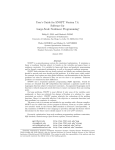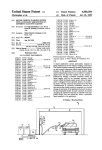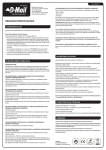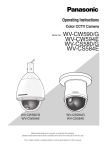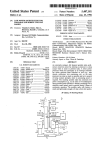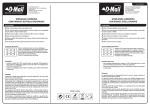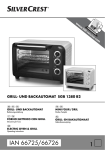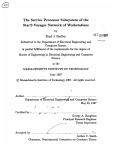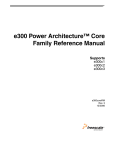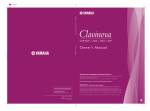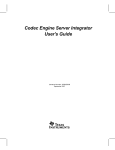Download Method and apparatus for software management of on
Transcript
US006859862B1 (12) United States Patent (10) Patent N0.: (45) Date of Patent: Liao et al. (54) METHOD AND APPARATUS FOR SOFTWARE MANAGEMENT OF ()N_CHIP 5,604,909 A 5,632,025 A CACHE 5,638,500 A 5,694,567 Inventors: Yu-Chung (Us); Peter A. Howard Sandon, CI Lia‘), Cheng, Essex Austin, Redmond, Junction, WA VT , , A 2 (US); Peter Hsu, Fremont, CA (US) ( ) , _ Notice: _ 2/1997 Joshi et al. ............... .. 712/208 5/1997 Bratt et al. ..... .. 711/152 6/1997 Donovan et a1. 12/1997 j// Bourekas et al. 345/625 ..... . . . . .. Van gurgartetlal' ra HOOk e a . et............... a1. .. 711/3 / FOREIGN PATENT DOCUMENTS _ _ JP 62197842 9/1987 SubJect to any disclaimer, the term of this JP 63086048 4/1988 patent is extended or adjusted under 35 JP 4080844 3/1992 U.S.C. 154(b) by 0 days. JP 5120134 5/1993 OTHER PUBLICATIONS (21) Appl. N0.: 09/545,184 _ Feb. 22, 2005 (List continued on next page.) (73) Assignee: Nintendo Co., Ltd., Kyoto (JP) * A US 6,859,862 B1 _ Motorola Inc., “PoWerPC Microprocessor Family: The Pro (22) Flled' Apr‘ 7’ 2000 gramming Environments”, 1994. (Under 37 CFR 147) IBM, “PoWerPC 740 and PoWerPC 750 RISC Microproces 7 (51) Int. Cl. .............................................. .. G06F 12/08 (52) US. Cl. ..................... .. 711/129; 711/130; 711/133; (58) Field of Search 711 153' 711 152 """""""""""""""" " 911/130 ’ /129 ’ 711/133, 170, 123, 217, 214, 215, 220, 219, 173, 163, 152, 153; 712/35, 36, 22, 222, 4 (56) References Cited US PATENT DOCUMENTS 5,170,474 A 12/1992 Sakamura et a1, ,_ * A microprocessor including a control unit and a cache locked Cache Portion and a normal Cache Portion The normal Cache Portion is Controlled by a hardware imple ______ __ 707/6 mented automatic replacement process. The locked cache portion is locked so that the automatic replacement process 2/ 1996 cannot modify the contents of the locked cache. An instruc Huck et al- - - - - - 4/1996 Brennan et a1 5,526,504 A 6/1996 2 HS“ et a1‘ ' ' ' ' ' ' ' - - - -- 711/125 711/119 ' ' ' " 711/207 glitz“: a1‘ " 7/1996 Reiningérme't";1' ' ' ' ' 5,572,704 A 11/1996 Bratt et a1. 5,588,138 A 12/1996 Bai et al. 5,594,886 A ABSTRACT 2/1993 Keith et al. ............ .. 712/225 5510934 A 5’539’892 A (57) either a single cache or as a partitioned cache having a 4/1978 Appell et a1. ............. .. 709/100 12/1979 Appell et a1. .......... .. 711/163 5,493,667 A Primary Examiner—Pierre-Michel Bataille (74) Attorney, Agent, or Firm—Nixon & Vanderhye P.C. connected With the control unit for storing data to be used by the control, Wherein the cache is selectively con?gurable as 4 084 224 A 4,177,510 A 5,187,793 A sor Family User Manual”, 1998. Byte Magazine, “Zen and the Art of Cache Maintenance”, 1997. ..... ..... tion is provided in the instruction set that enables softWare to selectively allocate lines in the locked cache portion to correspond to locations in an external memory, thereby ' ' ' " 711/207 enabling the locked cache portion to be completely managed . . . .. 711/161 by Softwam . . . .. 711/173 1/1997 Smith et al. .............. .. 711/136 2 Claims, 4 Drawing Sheets DMA_L bit settings Bit(s) Name Description 0-26 LC_ADDR 27 DMA_LD High order bits of the starting address in locked cache. Load command 0 Store - transfer from locked cache to external memory 1 Load - transfer from external memory to locked cache 28-29 DMA_LEN_L 30 DMA_T . Low order bits of transfer length in cache lines Trigger bit. _ I 0 DMA command Inactive 1 DMA command is ready to be queued. 31 DMA_F Flush bit. _ 0 Normal DMA operation 1 Flush the DMA queue. US 6,859,862 B1 Page 2 US. PATENT DOCUMENTS 5,974,507 A 10/1999 Arimilli et a1. ........... .. 711/133 4/1998 Gossett et a1. ............ .. 345/611 5,974,508 A 5,978,888 A 10/1999 11/1999 27232245‘ 2 * 18/1332 gubgy ------ --1-------------- ~~ iii/i2; 5,982,939 A 11/1999 Van Hook ................ .. 382/255 6,000,014 A 12/1999 6,014,728 A 1/2000 Baror .... .. 3/2000 Green Jacobs ...................... .. 711/133 5,742,277 A 7 7 / at age eta' " ' / 5,864,703 A 5,875,464 A 1/1999 Van Hook et a1. .......... .. 712/22 . 2/1999 Klrk ......................... .. 711/129 5,875,465 A 2/1999 Kllpatnck et a1. 5,898,854 A 5,931,945 A 4/1999 Abramson et a1. ........ .. 712/218 8/1999 Yung et a1. ............... .. 712/300 5,933,157 A 5,933,650 A 8/1999 Van Hook et a1. 345/563 8/1999 Van Hook et a1. ............ .. 712/2 5,938,756 A 8/1999 5,954,815 A 5,966,734 A . . 711/134 Van Hook et a1. .......... .. 712/23 9/1999 Joshi et a1. ........ .. 6,044,478 A * 6,047,358 A * 4/2000 6,205,548 B1 * 3/2001 6,438,655 B1 * 8/2002 6,493,800 B1 * 12/2002 6681 296 B2 * 7 7 712/237 10/1999 Mohamed et a1. ........ .. 711/173 * cited by examiner Maheshwari .............. .. 711/133 Arim?li et a1‘ ___________ " 711/128 Arimilli et a1. ........... .. 711/128 . 711/142 ...................... .. 711/141 Hasbun . 711/170 . Nlcol et a1. ............... .. 711/136 . Blumnch .................. .. 711/129 H2004 L. t 1 ‘a0 e a‘ """""""" " 711/129 U.S. Patent Feb. 22,2005 Sheet 1 0f 4 US 6,859,862 B1 Fig. 1 18 10 i ( i _ : Control Unit Instruction Fetch : : Branch Unit 1 v : System : Unit i _ _ _ . ' > _ v 32K lCache i i BHT/ BTIC Dispatch : } ii | _ 32 : i ' : 5 _ _ - _ _ _ _ _ _ _ v _ - _ - _ _ _ _ -."- - V - - - _ _ _ _ _ _ _ _ 2.2 l 2 =E : GPRs ; FXU1 FXU2 ‘ _ _ _ _ _ _ V FPRs ‘ ; + Rename _ _ _ _2_§ LSU _ _ V 202 Buffers _ Rename k V Buffers _» ‘ _ A M v 34 3A2 : 3Q l V ) l 32‘? Dcache/ L2 Tags < opt'ma' L°°a' Memory Partition 38 I I 40 ‘ :' 'is'sk' ': 60X !L2 Cache: BlU/DMA V _____ _ _ _ '— 36 j “ “ V 7i‘ ‘ i i : ‘V C 14 16 > External Memory d2 U.S. Patent Feb. 22, 2005 US 6,859,862 B1 Sheet 2 0f 4 HlD2 register bit settings Bit(s) Name 0 LSQE Description Load/Store quantized enable (non-indexed format) 0 psq_l[u] and psq_st[u] instructions are illegal 1 psq_l[u] and psq_st[u] instructions can be used 1 WBE 2 PSE Write buffer enable 0 write buffer is disabled 1 write buffer enabled to gather non-cacheable data Paired singles enabled 1 0 paired singles instructions are illegal 1 paired singles instructions can be used 3 LCE Locked cache enable 0 Cache is not partitioned - 32 kB of normal cache 1 Cache is partitioned - 16 kB of normal cache and 16 kB of locked cache available 4-7 DMAQL DMA queue length (read only) the number of used queue positions in the DMA from O (queue empty) to 15 (queue full) 8-31 - Reserved Fry. 2 dcbz_l Data Cache Block Set to Zero Locked dcbz__l F 0 rA, rB 4 00000 56 A 1011 B 1516 Fig. 3 1014 2021 0 3031 U.S. Patent Feb. 22, 2005 Sheet 4 0f 4 US 6,859,862 B1 DMA_U bit settings Bit(s) Name Description 0-26 MEM_ADDR High order address bits of starting address in main memory 27-31 DMA_LEN_U High order bits of transfer length in cache lines Fig. 5 DMA_L bit settings Bit(s) Name Description 0-26 LC_ADDR 27 DMA_LD High order bits of the starting address in locked cache. Load command 0 Store - transfer from locked cache to external memory 1 Load - transfer from external memory to locked cache 28-29 DMA_LEN_L . Low order bits of transfer length in cache lines 30 DMA_T Trigger bit. 31 DMA_F Flush bit. 0 Normal DMA operation 0 DMA command inactive 1 DMA command is ready to be queued. 1 Flush the DMA queue. Fig. 6 US 6,859,862 B1 1 2 METHOD AND APPARATUS FOR SOFTWARE MANAGEMENT OF ON-CHIP CACHE effective use of the cache can be a critical factor in obtaining optimal performance for applications running on a micro processor. The drastic time difference betWeen loading desired code or data from an on-chip cache as compared to loading from the main memory is so great (an order of magnitude or more) that effective cache management can be a dominant factor in determining the speed of an application executed by the microprocessor, or even the speed of the CROSS-REFERENCE TO RELATED APPLICATIONS This application is related to US. application Ser. No. 09/545,182, entitled “METHOD AND APPARATUS FOR OBTAINING A SCALAR VALUE DIRECTLY FROM A VECTOR REGISTER” and US. application Ser. No. 09/545,183, entitled “METHOD AND APPARATUS FOR EFFICIENT LOADING AND STORING OF VECTORS”, 10 ?led by the same inventors on the same date as the instant application. Both of these related cases are hereby incorpo rated by reference in their entirety. 15 FIELD OF THE INVENTION This invention relates to microprocessors, and, more particularly, to a method and apparatus Which improves the entire system built around the microprocessor. Generally speaking, a cache operates by storing data and/or instructions that have been previously requested by the control unit and retrieved from main memory in the on-chip cache for possible use again by the control unit at a later time. If a second request is made by the control unit for that same data, the data can be quickly retrieved from the cache rather than having to again retrieve the data from the off-chip main memory. In this manner, the speed of the application can be increased by minimiZing the need to access the relatively sloW main memory. One limitation, hoWever, regarding the use of cache is that operational efficiency of microprocessors having on-chip siZe and cost factors limit the cache to a siZe that is cache by enabling softWare management of at least a portion signi?cantly small relative to the siZe of the main memory. As a result, the cache quickly becomes full With data that has been retrieved from main memory or elseWhere, thereby of the cache. BACKGROUND OF THE INVENTION 25 The electronic industry is in a state of evolution spurred by the seemingly unquenchable desire of the consumer for better, faster, smaller, cheaper and more functional elec tronic devices. In their attempt to satisfy these demands, the electronic industry must constantly strive to increase the speed at Which functions are performed by microprocessors. Trademark) family of microprocessors (hereafter “PoWerPC”), includes a 32 kilobyte (32 k) on-chip level one (L1) instruction (I) cache and a 32 K L1 data (D) cache (Harvard Architecture), as Well as a level tWo (L2) cache providing additional on-chip cache functionality. For more Videogame consoles are one primary example of an elec information on the PoWerPC microprocessors see PowerPC tronic device that constantly demands greater speed and 740 and PowerPC 750 RISC Microprocessor Family User Manual, IBM 1998 and PowerPC Microprocessor Family: The Programming Environments, Motorola Inc. 1994, both of Which are hereby incorporated by reference in their reduced cost. These consoles must be high in performance and loW in cost to satisfy the ever increasing demands associated thereWith. The instant invention is directed to increasing the speed at Which microprocessors can process information by improving the efficiency at Which data and/or instructions can be loaded for processing. A cache is a high speed memory that is provided on the entirety. In vieW of the siZe limitation on caches, the micropro 40 microprocessor chip for the purpose reducing the number of times that data required for executing commands must be retrieved from main memory. Cache devices provide a close and convenient place for storing data and/or instructions to be used by the control unit of the microprocessor in a fast and efficient manner. Today, all high-performance micro processors incorporate at least one on-chip level one (L1) preventing additional data required by the control unit from being stored in the cache. Typically, a microprocessor, such as the microprocessors in IBM’s PoWerPC (IBM 45 cache for storing previously used data and/or instructions. Main memory is external to the microprocessor and access thereto is provided through a bus Which connects the cessor includes hardWare that manages the cache in accor dance With an algorithm that attempts to predict Which data read from main memory is likely to be needed again in the near future by the processing unit. In other Words, the cache control hardWare is designed according to an algorithm that tries to predict in advance What data from main memory to maintain in the limited amount of storage space available in the cache for later use by the processing unit. Thus, every microprocessor having such a cache incorporates some type of hardWare implemented algorithm for managing the con tents of the cache. An example of such an automatic replace ment algorithm used in the PoWerPC is a pseudo least recently-used (PLRU) replacement algorithm microprocessor to the main memory. The bus connecting the microprocessor and the main memory is controlled by a Bus Interface Unit (BUI). Due to the fact that the main memory accesses must go through the BUI and bus to obtain the 55 requested data from the off-chip memory, accessing this The automatic replacement algorithm used in a particular microprocessor to manage the contents of the cache, hoWever, is not necessarily optimal or even effective for certain applications run by the microprocessor. In other memory is relatively inconvenient and sloW as compared to Words, the algorithm implemented by cache control hard accessing the on-chip cache. With today’s technology, accessing the off-chip main Ware does not alWays result in efficient cache management for all applications designed for the microprocessor. For example, in certain applications the hardWare may drop data memory can take anyWhere from ten to hundreds of CPU clock cycles (a time unit by Which the microprocessor or central processing unit (CPU) operates). In contrast, access from the cache right before it is needed a second time, ing on-chip memory, such as a memory designed to operate from main memory, even though the desired data Was in the thereby requiring the processor to obtain the dropped data as an on-chip cache, can take as feW as only one or tWo CPU clock cycles. Thus, data can be retrieved from a cache at least about ten times faster than the time that it Would take to retrieve that same data from main memory. As a result, 65 cache moments earlier. This problem results from the fact that one cannot predict in advance the needs of every application that may be implemented using the micropro cessor. As a result, some applications Will not be able to use US 6,859,862 B1 3 4 the cache in an ef?cient manner, thereby preventing such applications from running as fast as they otherwise could With ef?cient cache management. In fact, for some modi?es data in the cache. This instruction can be a useful tool for boosting performance When Zeroing a large block of applications, the automatic replacement algorithms perform poorly, thereby preventing the desired loW-latency memory data. Again, these three instructions have only a limited ability to provide softWare assistance to the cache manage ment hardWare, because the hardWare is still in control of the accesses for Which the cache is designed. One strategy that has been used in the past in connection cache in accordance With the hardWare algorithm. data in the cache and Will continue to operate on the entire With caches to improve application performance is to pro Thus, While some tools are available for programmers to vide in the instruction set of the microprocessor a mecha nism that enables softWare assisted cache management. use in order to try and help their particular application utiliZe the cache in an ef?cient manner, the cache is still ultimately controlled by the cache management hardWare. As a result, Most modern microprocessors provide instructions in the instruction set Which enable softWare to assist the cache if the replacement algorithm implemented by the hardWare management hardWare to some degree in managing the cache. For example, the PoWerPC architecture contains several user-accessible instructions in the instruction set for does not perform Well for a particular application, the application Will not run in an optimal manner on the 15 manipulating the data cache that can signi?cantly improve overall application performance. These instructions are: “block touch” (dcbt); “block touch for store” (dcbtst); “block ?ush” (dcbf); “block store” (dcbst); and “block set to Zero” (dcbZ) see Zen and the Art of Cache Maintenance, Byte Magazine, March 1997. that can be provided by instructions such as those described above. In other Words, the programmer cannot completely control the contents of any portion of the cache With these or similar softWare techniques. Thus, many applications do not run as fast as they otherWise could if the cache could be managed in a more ef?cient manner for the particular In order to understand the operation of these or similar instructions, it is important to de?ne What a “block” is in this conteXt. A block is the fundamental unit of memory on Which the cache operates. The cache handles all memory 25 load and store operations using blocks. The particular block memory (SPM), i.e. an on-chip memory that does not eXample, the PoWerPC 601 uses 64-byte blocks, While the perform demand-driven, automatic replacement of memory PoWerPC 603 and 604 user 32-byte blocks. Each of the above-identi?ed instructions operates on a blocks. An SPM can be used by the application to store, for eXample, data from a contiguous portion (memory block) of pair of general purpose register (GPR) operands Whose sum the main memory, Wherein a base address of the contiguous memory block is de?ned in a speci?c register created for this purpose or is de?ned using the memory management facili ties that eXist for accessing other parts of the memory 35 a cache. Some microprocessors have enabled a certain contiguous range of the available address space to be allocated to the SPM. While use of on-chip SMP can 40 secondary cache) into the primary data cache, thereby help SUMMARY OF THE INVENTION The instant invention enables more ef?cient use of on-chip cache, such as a level one data cache in the IBM PoWerPC or the like, by enabling the cache to be partitioned into a ?rst portion that operates in a conventional manner under hardWare control, and a second portion Which can be lar implementation in the PoWerPC family. The dcbtst completely controlled and managed by softWare. instruction behaves in a similar manner eXcept that it pro In a preferred embodiment of the invention, the entire vides the additional hint that the corresponding memory location is going to be overWritten soon. Thus, these tWo identi?ed block, the automatic replacement algorithm may overWrite that data in the cache before it can be used. As a result, these instructions have limited ability to help manage improve the performance of the microprocessor for certain applications, it does not solve the problem of cache man agement described in detail above. ing to avoid a cache miss, i.e. not ?nding the desired data in the cache When needed by the processor. It is noted that these instructions only provide “hints” to the processor and do not require that the processor actually load the data block identi?ed by the instructions. In other Words, the hints are taken under advisement by the processor Which then decides based on other needs Whether the data block Will be loaded. These hints are treated differently depending on the particu instructions do not provide direct control over the contents of the cache. Moreover, even if the processor does load the system. HoWever, SPM is a memory, not a cache, and therefore does not provide the advantages or functionality of from memory, the dcbt instruction can be used to request that the processor bring data from memory (or from a application. Accordingly, a need eXists for improving the use of cache in a microprocessor on an application speci?c basis. The instant invention satis?es this need. It is noted that, in addition to cache, some microproces sors have on-chip memory that can be used as a scratch pad siZe can vary from one microprocessor to another. For forms the effective address of the memory location(s) to be affected by the instruction. The dcbt and dcbtst instructions provide “hints” to the processor that the addressed data block may be needed by the application in the near future, thereby giving the processor the option of loading, or at least allocating, the memory block in the cache. Thus, When placed appropriately ahead of the anticipated need for data microprocessor, regardless of the limited softWare assistance cache can be used as a conventional cache, or the cache can be recon?gured so as to de?ne part of the cache as a locked 55 softWare controlled cache, referred to herein as a “locked cache” or “scratch pad cache”. What is meant by “locked” in this conteXt is that the contents of the locked portion of the cache cannot be altered by the hardWare cache management the cache in an ef?cient manner for a particular application. The dcbf and dcbst instructions in the PoWerPC instruc system. By locking the portion of the cache designed for tion set force modi?ed (or dirty) data out of the cache and back into memory. The primary difference betWeen these tWo instructions is that dcbf not only copies data back to of the hardWare cache management system. As a result, poor performance can be avoided even if the hardWare algorithm does not Work Well for the needs of a particular application. The locking of the cache can be done by, for eXample, memory (like dcbst), but it also marks the corresponding softWare control, the cache can be managed independently cache block as invalid. The dcbZ instruction in the PoWerPC 65 providing a special purpose register (e.g. HID2) having a bit instruction set allocates a block of data in the cache and then (e.g. 4th bit) Which controls Whether the cache is to function as a single hardWare controlled cache or a partitioned cache initialiZes the block to a series of Zeros. Thus, this instruction US 6,859,862 B1 5 6 including a locked software controlled portion. Other bits in the special purpose register can be used, for example, to control other enhancement options that may be available on FIG. 3 shoWs an exemplary instruction de?nition for addition to an instruction set of the microprocessor of FIG. 1 that may be used to allocate blocks in the locked cache, in accordance With one embodiment of the instant invention. FIG. 4 is a partial and more detailed vieW of the micro processor of FIG. 1, Wherein a preferred embodiment of a direct memory access (DMA) engine is shoWn for use in bringing data into and out of the locked cache, in accordance With one embodiment of the instant invention; and FIGS. 5 and 6 are tables shoWing an exemplary bit the microprocessor. In order to allocate blocks of memory in the locked cache, at least one additional instruction (e.g. dcbzil) is preferably provided in the instruction set of the microprocessor that implements this invention. This additional instruction is used to control on a block-by-block basis exactly What data is contained in the locked portion of the cache, thereby giving the application programmer complete freedom to 10 keep or remove blocks of data from the cache as required for de?nition for tWo exemplary special purpose registers used ef?cient processing of his application. In this Way, the in the DMA engine of FIG. 4, in accordance With the one embodiment of the instant invention. utiliZation of the cache can be maximiZed regardless of the particular hardWare algorithm used to manage the normal or DETAILED DESCRIPTION OF THE PREFERRED EMBODIMENTS non-locked portion of the cache. Moreover, by enabling selective partitioning of the cache into a locked and regular cache, the entire cache can still be used in the conventional manner if it is determined that the hardWare algorithm Will Work satisfactorily for a particular application. On the other hand, if it is determined that the particular application Would perform better using a portion of the cache as a softWare controlled cache, the cache may be partitioned and locked so that the locked portion can be managed exclusively by the softWare. The locked portion of the cache is basically a scratch pad 25 memory (SPM) but Which operates as a cache instead of a memory. Thus, the invention provides a locked cache or scratch pad cache (SPC) that can be used and managed solely by the application, Without interference from the hardWare cache management system, to increase the effi ciency of the application on a particular microprocessor. A major advantage of the locked cache as compared to a convention scratch pad memory is that the locked cache alloWs ?exibility of softWare management for data that does not exhibit the spatial and temporal locality for Which nection and operation, are Well knoWn to one skilled in the art. Thus, in order not to obscure the instant invention With 35 instant invention for a person skilled in the art. normally managed cache, and then continually replace itself, different characteristics, is high usage instruction libraries or data tables Which do not ?t in the cache, but have access patterns that Would cause thrashing if they are managed by hardWare. The invention overcomes these and other prob lems by alloWing 100% softWare control of a portion of the cache. In accordance With a preferred embodiment of the invention, a direct memory access (DMA) engine is pro vided in the microprocessor and is used to transfer data betWeen the locked data cache and the external memory. The details regarding knoWn elements, the draWings and descrip tion herein are presented in a simpli?ed form and only to the extent necessary to provide a full understanding of the normal caches are designed. One example is a multimedia data stream that is larger than the cache, and is used once and then discarded. Such data Would replace all other data in a yielding very loW cache hit rates. Another example, having In the folloWing description, numerous speci?c details are set forth regarding a preferred embodiment of the instant invention. HoWever, the speci?c details are meant to be exemplary only and are not meant to limit the invention to the particular embodiment described herein. In other Words, numerous changes and modi?cations may be made to the described embodiment Without deviating from the true scope and spirit of the instant invention, as a person skilled in the art Will readily understand from revieW of the description herein. FIG. 1 is a diagram of a single-chip microprocessor 10 in Which the present invention has been implemented. It is noted that FIG. 1 only shoWs a simpli?ed representation of a microprocessor, due to that fact that the majority of the elements in the microprocessor, as Well as their intercon The microprocessor 10 is connected, in a knoWn manner, 40 to an off-chip (external) memory 12 or main memory via an address bus 14 and data bus 16. The external memory 12 contains data and/or instructions, such as 3D graphics instructions, needed by the microprocessor 10 in order perform desired functions. It is noted that the microproces 45 sor 10 and external memory 12 may be implemented in a larger overall information processing system (not shoWn). The microprocessor includes a control unit 18, ?xed point units 20a and 20b, general purpose registers (GPRs) 22, a load and store unit 24, ?oating point unit 28, paired single unit (vector processing unit) 30 and ?oating point registers pose registers (SPR) used respectively to control one DMA 26, all of Which generally interconnect and operate in a knoWn manner. In addition, the microprocessor 10 includes transfer into and out of the locked cache. a level one instruction cache 32, a level one data cache 34, DMA engine’s operation is controlled by tWo special pur BRIEF DESCRIPTION OF THE DRAWINGS a level tWo cache 36 With associated tags 38, and bus 55 Other objects, features and advantages of the instant invention Will become apparent upon revieW of the detailed description beloW When read in conjunction With the accom interface unit/direct memory access engine (BIU/DMA) 40. In this embodiment, the instruction cache 32, level tWo cache 36 and level tWo cache tags 38 generally operate in a conventional manner. HoWever, as Will be explained in detail beloW, the data cache 34 and the direct memory access panying draWings, in Which: unit have special operations and features in accordance With FIG. 1 is a general block diagram of an exemplary microprocessor and external memory illustrating a preferred embodiment of the instant invention; the instant invention. FIG. 2 is a table shoWing an exemplary special purpose register used to control the partitioning of the cache and other optional enhancements to the microprocessor of FIG. 1, in accordance With one embodiment of the instant inven cessor 10 is similar to IBM’s PoWerPC microprocessors, tion; The structure and operation of this exemplary micropro 65 With certain modi?cations to implement the instant inven tion. Details regarding the operation of most of the elements of this exemplary microprocessor are found in the folloWing publications: PowerPC 740 and PowerPC 750 RISC Micro US 6,859,862 B1 7 8 processor Family User Manual, IBM 1998 and PowerPC from memory that are loaded from an eight-Word boundary Microprocessor Family: The Programming Environments, (i.e., bits A(27—31) of the logical (effective) addresses are Motorola Inc. 1994. It is noted, however, that the instant invention may be implemented on any suitable micropro cessor or information processing system to improve the management of cache. In the exemplary embodiment of FIG. 1, the micropro cessor includes separate 32-Kbyte, eight-Way associative instruction and data caches (32 and 34) to alloW the various Zero). As a result, cache blocks are aligned With page boundaries. Address bits A(20—26) provide the index to select a cache set. Bits A(27—31) select a byte Within a block. The on-chip data cache tags are single ported, and load or store operations must be arbitrated With snoop accesses to the data cache tags. Load and store operations can be performed to the cache on the clock cycle immediately of relatively sloW accesses to the external memory 12. The folloWing a snoop access if the snoop misses. Snoop hits may block the data cache for tWo or more cycles, depending on Whether a copy-back to main memory 12 is required. caches preferably implement a pseudo least-recently-used (PLRU) replacement algorithm for managing the contents of The level one (L1) caches (32 and 34) are preferably controlled by programming speci?c bits in a ?rst special execution units (18, 20a, 20b, 28 and 30) and registers rapid 10 access to instructions and data, thereby reducing the number the caches. The cache directories are physically addressed, 15 purpose register (HIDO—not shoWn) and by issuing dedi the physical (real) address tag being stored in the cache directory. Both the instruction and data caches have 32-byte register preferably contains several bits that invalidate, cache block siZe, Wherein a cache block is the block of memory that a coherency state describes (also referred to as cache 34 is automatically invalidated When the micropro cated cache control instructions. The HIDO special purpose disable, and lock the instructions and data caches. The data a cache line). TWo coherency state bits for each data cache cessor 10 is poWered up and during a hard reset. HoWever, a soft reset does not automatically invalidate the data cache. SoftWare uses the HIDO data cache ?ash invalidate bit (HIDO(DCFI)) if the cache invalidation is desired after a soft block alloW encoding for three states—Modi?ed (exclusive) (M), Exclusive (unmodi?ed) (E), and Invalid (I)—thereby de?ning an MEI three-state cache coherency protocol. A single coherency state bit for each instruction cache block alloWs encoding for tWo possible states: invalid (INV) or Valid In accordance With the instant invention, each cache can be invalidated or locked by setting the appropriate bits in a hardWare implementation-dependent register (a reset. Once the HIDO(DCFI) is set through move-to-special 25 matically clears this bit in the next clock cycle (provided that the data cache is enabled in the HIDO register). The data cache may be enabled or disabled by using the data cache enable bit (HIDO(DCE)) Which is cleared on poWer-up, disabling the data cache. When the data cache is in the disabled state (HIDO(DCE)=0), the cache tag state bits are ignored, and all accesses are propagated to the L2 cache special purpose register described in detail beloW). The microprocessor 10 preferably supports a fully coherent 4-Gbyte physical address space. Bus snooping is used to drive the MEI three-state cache coherency protocol that ensures the coherency of global memory With respect to the processor’s data cache. The data cache 34 coherency protocol is a coherent subset of the standard MESI four-state cache protocol that omits the shared state. The data cache 34 characteriZes each 32-byte block it contains as being in one of three MEI states. Addresses presented to the cache are indexed into the cache directory With bits A(20—26), and the upper-order 20 bits from the physical address translation (PA(0—19)) are compared against the indexed cache direc tory tags. If neither of the indexed tags matches, the result 36 or 60x bus as single beat transactions. The contents of the data cache can be locked by setting the data cache lock bit 35 (HIDO(DLOCK)). A data access that hits in a locked data cache is serviced by the cache. HoWever, all accesses that miss in the locked cache are propagated to the L2 cache 36 or 60x bus as single-beat transactions. The microprocessor 40 snoop hits in an unlocked data cache. HoWever, any cache block invalidated by a snoop remains invalid until the cache is unlocked. The instruction cache 32 operates in a similar manner as the data cache described above, except that different bits are used in the HIDO register for invalidation 10 treats snoop hits in the locked data cache the same as is a cache miss (required data not found in cache). On a cache miss, the microprocessor cache blocks are ?lled in four beats of 64 bits each. The burst ?ll is performed as a 45 critical-double-Word-?rst operation—the critical double and locking, i.e. instruction cache ?ash invalidate bit HIDO (ICFI) and instruction cache lock bit HIDO(ILOCK). The microprocessor preferably includes another hardWare Word is simultaneously Written to the cache and forWarded to the requesting unit, thus minimiZing stalls due to cache ?ll latency. If a tag matches, a cache hit occurred and the directory indicates that state of the cache block through tWo implementation-dependent special purpose register (HID2) that, in accordance With the instant invention, is used to modify hoW the data cache 34 is con?gured and used. Speci?cally, the HID2 register contains a lock cache enable state bits kept With the tag. The microprocessor 10 prefer ably has dedicated hardWare to provide memory coherency bit (LCE) that controls Whether the data cache 34 is con by snooping bus transactions. ?gured as 32 kB of normal (hardWare managed) cache Both caches 32 and 34 are preferably tightly coupled into the bus interface unit (BUI) 40 to alloW ef?cient access to the system memory controller and other potential bus mas ters. The BUI 40 receives requests for bus operations from the instruction and data caches, and executes operations per the 60x bus protocol. The BUI 40 provides address queues, purpose-register (mtspr) operation, the microprocessor auto (LCE=0) or is partitioned into a 16 kB of normal cache 34a 55 and a 16 kB of locked cache 34b that can be controlled exclusively by softWare (LCE=1). Speci?cally, at poWer-up or reset, HID2(LCE) is set to be 0. Thus, at this time, the L1 data cache 34 is a 32 kB 8-Way set-associative cache. HoWever, When a move-to-special-register (mtspr) instruc prioritiZing logic and bus control logic. The BUI also tion sets HID2(LCE)=1, the data cache is con?gured as tWo captures snoop addresses for data cache, address queue and memory reservation operations. The data cache is preferably partitions. The ?rst partition 34a, consisting of Ways 0—3, is organiZed as 128 sets of eight Ways, Wherein each Way consists of 32 bytes, tWo state bits and an address tag. In accordance With the instant invention, an additional bit may be added to each cache block to indicate that the block is locked. Each cache block contains eight contiguous Words then a 16 kB normal cache. The second partition 34b, consisting of Ways 4—7, is then a 16 kB locked cache. The normal cache portion 34a operates like the unpartitioned 65 cache 34, except that it behaves as a four-Way set-associative cache. The operation of the locked cache partition 34b is described beloW. US 6,859,862 B1 10 An example de?nition for the HID2 register is shown in FIG. 2, Wherein bit number 3 is the LCE bit for controlling hoW the data cache 34 is con?gured. The other bits in the In accordance With a preferred embodiment of the instant invention, the microprocessor implements a DMA engine 40b, as shoWn in FIG. 4, to transfer data betWeen the locked L1 data cache 34b and the external memory 12. The DMA engine 40b has a 15-entry FIFO queue for DMA commands HID2 register are used to control other enhanced features that may be provided in the microprocessor 10, such as data quantization, Write buffering, paired singles operations, and DMA queue length as shoWn on FIG. 2. It is noted that, While FIG. 2 shoWs that bits 8—31 of the HID2 register are reserved, these bits may be used to indicate, for example, cache instruction hit error, DMA access to normal cache 10 error, DMA cache miss error, DMA queue length over?oW error, instruction cache hit error enable, DMA cache miss 15 for example, instructions generally corresponding to the dcbt, dcbst, dcbZ, dcbst, dcbf, dcbi and icbi instructions in the PoWerPC instruction set. The ?rst six of these instruc tions have similar operation as described above With respect to the PoWerPC instruction set, except that they noW, in As shoWn in FIG. 5, the DMAiU register is a 32-bit register containing bits 0 through 31, Wherein bits 0 through error enable, and DMA queue over?oW error enable. The microprocessor includes cache control instructions for controlling both the instruction and data caches, such as, and processes the commands sequentially. The operation of the DMA engine 40b is controlled by tWo special purpose registers: DMAU and DMAL. The exemplary de?nitions of the special purpose registers, DMAU and DMAL, are shoWn in FIGS. 5 and 6, respectively. 20 26 comprise 27-bit high order address bits representing a starting address in main memory and bits 27—31 comprise 5 high order bits representing transfer length in cache lines. As shoWn in FIG. 6, the DMAiL register is a 32-bit register including bits 0 through 31, Wherein bits 0 through 26 comprise 27 high order bits representing a starting address in the locked cache portion, bit 27 comprises a one-bit load command that encodes Whether direct memory access trans fer is from the locked cache to external memory or from accordance With the instant invention, can be used in con external memory to locked cache, bits 28 through 29 com nection With both the locked portion 34b and the normal portion 34a of the data cache 34. The data cache block invalidate (dcbi) instruction is provided for invalidating a line in the locked portion 34b or the normal portion 34a of the data cache 34. The instruction cache block invalidate (icbi) instruction operates on the instruction cache 32 in prise tWo loW order bits representing the transfer length in cache lines, bit 30 comprises a trigger bit representing Whether to activate or deactivate direct memory access, and 25 access operation or ?ush of a queued direct memory access command. The DMA engine is disabled at poWer-up With HID2 generally the same manner as this same instruction operates in the PoWerPC. In accordance With an important aspect of the instant invention, a neW instruction is provided in the instruction set (LCE)=0. Setting HID2(LCE)=1 partitions the L1 data 30 latches values in DMAU and DMAL to form a DMA command, enqueues the command in the DMA queue and sets DMAL(T)=0. HID2(DMAQL) indicates the number of locked portion as a result of changing the lock cache enable 35 empty, i.e. HID2(DMALQ)=0, the DMA engine processes the commands sequentially. The starting address of the transfer in the data cache is DMAL(LCiADDR)||0b0000. FIG. 3, a data-cache-block-set-to-Zero-locked (dcbzil) 40 to allocate on a block-by-block basis any block in the available memory address space. In other Words, the allo cation does not have to be linear, ie does not need to correspond to a contiguous block of memory, in contrast to a typical scratch pad memory. Moreover, due to the fact that 45 softWare has complete control over the contents of the cache Without interference from the replacement algorithm (Which 50 algorithm, such a pseudo-LRU algorithm). As can be seen in FIG. 2, the dcbzil instruction bit pattern includes bits 0 through 32, Wherein bits 0 through 5 For a DMA store command, i.e. DMAL(LD)=0, the DMA engine performs a data cache look-up for each of the cache lines equentially from the starting address. For a look-up hit in the locked cache, the DMA engine initiates a 60x bus Write-With-?ush transaction to transfer the 32 byte data from load command, i.e. DMAL(LD)=1, the DMA engine per forms a data cache lookup for each of the cache lines register, bits 16 through 20 designate a second register, the 60 allocated, bits 21 through 30 encode a secondary op code of “1014”, and bit 31 encodes a reserved ?eld of “0”. The dcbzil instruction is preferably the only mechanism available to allocate a tag for a 32 byte block in the locked cache 34b to be associated With a particular address in memory. The dcbi and dcbf instructions are operable to deallocate cache lines in the locked cache 34b. the transfer is determined by DMAL(LD). DMAL(LD)=0 the locked cache 34b to the external memory 12. For a DMA 55 encode a primary op code of 4, bits 6 through 10 encode a reserved ?eld of “00000”, bits 11 through 15 designate a ?rst content of Which is to be added to the content of the ?rst register to provide a cache block address to be cleared or The starting address of the transfer in the external memory is DMAU(MEMiADDR)||0b0000. The number of cache lines to be transferred by the command is DMAU(DMAi LENiU)||DMAL(DMAiLENiL), except that a value of Zero speci?es a length of 128 cache lines. The direction of means a transfer from the locked cache to the external cache, While DMAL(LD)=1 means a transfer from the external memory to the locked cache. the locked portion 34b of the cache is actually locked, the controls the normal portion 34a of the cache 34 When partitioned, and controls the entire cache 34 When the cache is not partitioned, in accordance With a replacement DMA commands in the DMA queue, including the com mand in progress (if any). When the DMA queue is not FIG. 3 shoWs an exemplary de?nition for an instruction that can be used for this purpose. Speci?cally, as shoWn in instruction can be used for allocating lines or blocks in the locked cache. Preferably, the dcbzil instruction can be used cache 32 and enables the engine 40b. When a mtspr instruc tion sets DMAL(T)=1 and DMAL(F)=0, the DMA engine of the microprocessor 10 for allocating lines in the locked portion 34b of the data cache 34 When the cache includes the bit in the HID2 register to 1, ie HID2(LCE)=1. bit 31 comprises a ?ush bit encoding normal direct memory 65 sequentially from the starting address. For a look-up hit in the locked cache, the DMA engine initiates a 60x bus burst read transaction to transfer the data from the external memory 12 to the locked cache 34b. For all but the last read transaction associated With the DMA load command, the burst read transaction type is 0b01011. The last burst read transaction has a transaction type 0b01010. The micropro cessor 10 initiates the bust transaction type 0b01011 only for the DMA load commands. Preferably, the memory controller can use the information to pre-fetch the next cache line to improve the performance. US 6,859,862 B1 11 12 The DMA access to the cache, both DMA loads and DMA stores, Will result in a psuedo-LRU state transition Within the four-Way set associated With the cache line, but does not affect the MEI state. If the look-up misses the locked cache, ment of the invention described herein is preferred because both static and dynamic data can be managed, in large or small blocks, With very little additional hardWare beyond that Which is found in a normal cache. In fact, the invention the DMA engine transfers no data and continues to the next can be implemented simply by, for example, adding an cache line. Preferably, the only Way to ?ush the DMA engine additional bit to each cache line intended for locking Which enables the cache line to be locked, thereby enabling each of is to issue a mtspr instruction to set DMAL(f)=1. In this situation, the DMA engine ?ushes all the commands in the DMA queue, including the command in progress, and sets both DMAL(f)=DMAL(t)=0. Such an instruction should be folloWed by a sync instruction to ensure that the pending bus transaction associated With the discarded command, if any, complete before the DMA is engine accepts the next DMA command. It is noted that the microprocessor 10 is considered to be a decoder and executor for the particular instructions described herein. Thus, part of the instant invention involves the locked cache lines to be advantageously used as softWare controlled cache. It is noted that the instant invention is particularly advantageous When implemented in loW cost, high performance microprocessors, such as microprocessors designed and intended for use in videogame consoles for household use or the like. 15 While the preferred forms and embodiments have been illustrated and described herein, various changes and modi ?cation may be made to the exemplary embodiment Without deviating from the scope of the invention, as one skilled in providing an instruction decoder and executor for the neW instructions de?ned in the above description of the inven the art Will readily understand from the description herein. Thus, the above description is not meant to limit the scope tion. The invention, hoWever, is not limited to a hardWare of the appended claims beyond the true scope and sprit of the decoder or executor, such as a microprocessor, but also instant invention as de?ned herein. covers softWare decoders and executors provided by, for What is claimed is: 1. A microprocessor, comprising a control unit and a cache connected With the control unit for storing data to be example, a virtual machine, such as a softWare emulator of the instant microprocessor. In other Words, the invention also relates to softWare emulators that emulate the operation 25 of the instant microprocessor by decoding and executing the con?gurable as either a single cache or as a partitioned cache particular instructions described herein. The invention fur having a locked cache portion and a normal cache portion, the normal cache portion being controlled by a hardWare ther relates to a storage medium, such as a compact disk Which stores any or all of the unique instructions described implemented automatic replacement process, and further herein, thereby enabling a microprocessor or virtual Wherein the locked cache portion is locked so that the machine to operate in accordance With the invention described herein. As can be seen from the description above, the instant invention enables 100% softWare control of the locked automatic replacement process cannot modify the contents of the locked cache portion, an instruction that enables softWare to selectively allocate lines in the locked cache portion to correspond to portion of the cache, thereby enabling an application to locations in an external memory, and a direct memory access engine that controls transfer of control the contents of the locked cache in a manner that can boost performance as compared to normal cache operation. In other Words, the invention provides an improvement to the softWare assist cache management strategies that are available on, for example, the PoWerPC family of micro processors as described above, by enabling complete soft Ware control of a portion of the cache. By enabling complete softWare control of the locked cache, the invention provides a scratch pad cache for advantageous use by the applications programmer. In accordance With the invention, the is cache data betWeen the locked cache portion and the external memory, Wherein the direct memory access engine includes ?rst and second special purpose registers, Wherein the ?rst special purpose register controls trans fer of data from the external memory into the locked cache potion and the second special purpose register controls transfer of data from the locked cache portion to the external memory. 2. A microprocessor, comprising a control unit and a cache connected With the control unit for storing data to be may be partitioned to any suitable siZe and is not limited to equal partitions as described herein. Moreover, the instant used by the control unit, Wherein the cache is selectively invention may be implemented in one or more caches other than a level one data cache. con?gurable as either a single cache or as a partitioned cache having a locked cache portion and a normal cache portion, the normal cache portion being controlled by a hardWare Other approaches to managing memory as a scratch pad include locking the entire cache once data has been locked, adding a lock bit to the status line bits, and using a contiguous block of memory. The ?rst approach is appro priate for applications Where a static block of data is frequently accessed, such as ?xed data tables. HoWever, this approach does not Work Well if the data to be managed is changing, because there is signi?cant overhead in unlocking, changing data and relocking the cache. The second approach provides similar functionality to the instant invention, as used by the control unit, Wherein the cache is selectively implemented automatic replacement process, and further Wherein the locked cache portion is locked so that the automatic replacement process cannot modify the contents 55 of the locked cache portion, and an instruction that enables softWare to selectively allocate lines in the locked cache portion to correspond to locations in an external memory, Wherein the microprocessor further includes a hardWare described above, but requires additional hardWare support implementation dependent special purpose register beyond that Which is found in a normal cache. The third approach is less ?exible than the above described embodi ment of the instant invention, in that it constrains the data in the SPM to reside in a single large block. Thus, the embodi Which determines Whether the cache is con?gured as the single normal cache or the partitioned cache. * * * * *

















